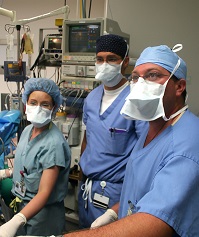Defense Medical Research and Development
Smart Oxygen Monitors to Diagnose and Treat Cardiopulmonary Injuries



Posted November 2, 2016
Michael Kinsky, MD, University of Texas, Galveston

University of Texas, Galveston
Rapid diagnosis and lifesaving interventions are critical for Soldiers suffering from chest trauma. When a Soldier has suffered a pulmonary injury, there is an increased need for inhaled oxygen to maintain proper oxygenation throughout the body. Impaired transport of oxygen occurs during hemorrhage, pulmonary injury, and other forms of shock that can compromise the cardiovascular system. Dr. Michael Kinsky from the University of Texas in Galveston was awarded funds through an FY12 Forward Surgical, Enroute Care, Shock, and Tissue Stabilization (FSECSTS) Program, Investigator-Initiated Award under the Joint Program Committee 6/Combat Casualty Care Research Program to develop a "Smart-Oxygenation-System (SOS)" to identify oxygenation deficits in pulmonary function or circulation using non-invasive, commercial off-the-shelf autonomous products. Dr. Kinsky and his team are constructing diagnostic and treatment algorithms using streamed and displayed novel oxygenation data. They hypothesize that SOS will lead to earlier recognition and judicious use of lifesaving interventions.
The goal of Dr. Kinsky's work is to implement a decision support system that displays and recommends therapies before clinical signs of deterioration. These early warning signals or novel recognition indicators use data from an autonomous closed loop control (CLC) of oxygen (fractional inspired oxygen (FiO2)) delivered by the ventilator. The amount of oxygen administered to the patient or FiO2 ranges from room air (FiO2 = 0.21) to pure oxygen (FiO2 =1.0). The CLC of FiO2 measures a patient's oxygen saturation (SpO2) via a pulse oximeter and then uses an algorithm to determine if the patient is within normal parameters. If the SpO2 is not within the normal parameters, the CLC adjusts a precise amount of oxygen needed for the patient. Dr. Kinsky has shown how this data can be used to develop novel algorithms by extracting the oxygenation data from the CLC into a smart oxygenation system (SOS). Specifically, the amount of FiO2 by CLC to the patient, the patient's oxygen saturation or SpO2, and a ratio of the two (SpO2/CLC-FiO2 or S/CLCF ratio) are graphically displayed on the SOS. Further, when a threshold value is reached e.g., S/CLCF ratio <250, an alert is sent to medical personnel that the patient's pulmonary function is failing. These SOS algorithms provide early warning alarms corresponding to mild, moderate, and severe Acute Respiratory Distress Syndrome (ARDS) and decision tools for initiation of life-saving interventions, such as triage priority. The experimental data indicate that the SOS decision support prototype utilizing a defined threshold can predict evolving lung injury prior to clinical signs of distress, allowing for implementation of rescue ventilation several hours earlier than standard-of-care guidelines and earlier life-saving interventions, thus translating to improved outcomes.
While Dr. Kinsky's efforts are promising, the inclusion of CLC-FiO2 systems in commercialized ventilators is largely limited to Intensive Care Units, Level III, or higher medical locations for combat casualty care. The greatest impact will be felt when there is broad availability of standalone CLC oxygen systems that are untethered to ventilators and provide earlier warning of pulmonary injury so that interventions can be initiated more rapidly.
Publications:
Liu NT, Salter MG, Khan MN, Branson RD, Enkheebetaar P, Kramer GC, Salinas J, Marques NR, and Kinsky MP. 2016. Closed-loop control of FiO2 rapidly identifies need for rescue ventilation and reduces ARDS severity in a conscious sheep model of burn and smoke inhalation injury. Shock [Epub ahead of print]
Kinsky MP, Ribeiro N, Cannesson M, Deyo D, Kramer G, Salter M, Khan M, Ju H, Johnston WE.Peripheral venous pressure as an indicator of preload responsiveness during volume resuscitation from hemorrhage. Anesth Analg. 2016 Jul;123(1):114-22.
Patent Pending:
Smart oxygenation system for evaluating pulmonary function. 2016 Inventors: Michael Kinsky MD, Rich Branson RT, George Kramer PhD, Muzna Khan RT, Jose Salinas PhD
Links:
Public and Technical Abstracts: Smart Oxygen Monitors to Diagnose and Treat Cardiopulmonary Injuries
Last updated Thursday, December 5, 2024














